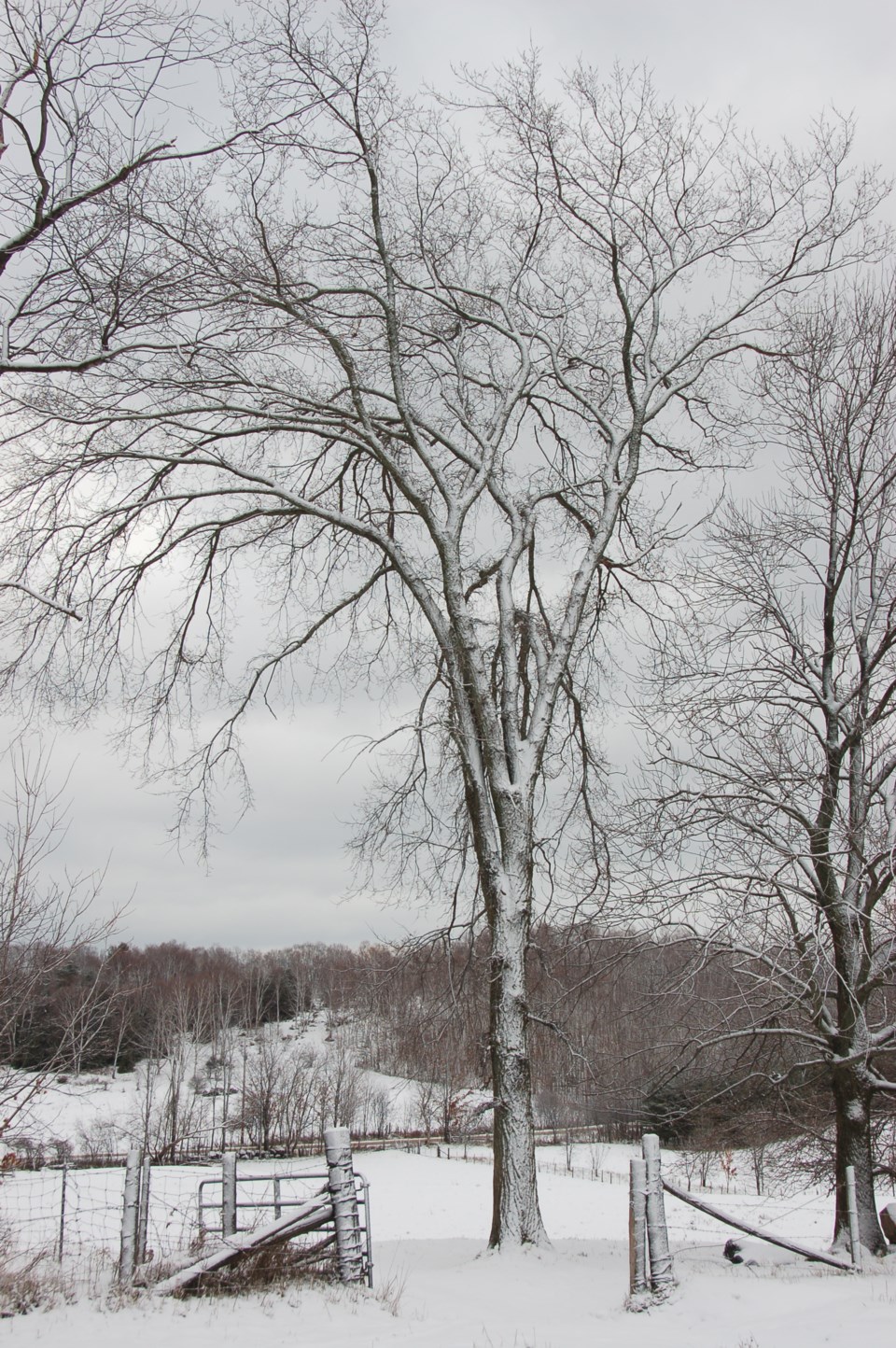Behold the stately elm tree, once a given to be seen on any countryside drive or walk.
Not so much these days. However, with a bit of keen observation, you may still catch sight of one growing on the limestone flats out Carden way or perhaps a relic within a fence line of a farm in Oro-Medonte Township.
This tree species has been hit hard by a killing disease and few remain that invoke memories of tree-lined country roads replete with swinging oriole nests. I have looked at a great many old photographs of rural settings, and from 1900 to about 1950 every pic has a good-sized elm tree standing proudly upon the property.
For those of us who have noticed our grey hair turning to an off-white, we can no doubt recall these images. So, are these trees now gone forever? Will the tall, vase-shaped silhouette of a magnificent elm ever again be noted within the landscape?
The answers are found with an interesting delve into the natural history of this native hardwood tree. While usually associated with roadsides or fence lines, elm are actually quite at home in damp soil. Many an elm has been found in the depths of a balsam fir swamp.
The Indigenous peoples who were the first human inhabitants of this area used the bark of elm to fashion the outside layer of their longhouses. As the tree grew in a damp environment, the cellular structure of the inner bark made it somewhat easy to pull from the trunk. Not waterproof or flexible like the bark from white birch, but tough and, when applied like overlapping shingles, made a darn fine shelter.
Due to the imposing figure of a tall and spreading elm, certain trees were regarded as ‘council trees,’ a place where generation after generation of humans could gather, interact, reflect and plan.
Such a tree once stood in Medonte Township, affectionately called Elsie. She stood tall and oversaw the coming of the Europeans, the establishment of a timber mill at her base and, later, the return of a surrounding forest.
There is more than one species of elm in the area, there being slippery elm (also employed by the early inhabitants as medicinal), rock elm and white elm (more commonly called American elm). There have been many hybrid varieties of elm bred around the world that have produced names like Chinese elm and Dutch elm. (Did you jump a little when you read that last one?)
Dutch elm disease is what killed more than 70 per cent of the elm in North America.
The sad story begins in Holland with the development of a new elm hybrid designed for landscaping, suitably called Dutch elm. As it was prone to occasional attack by a fungus that was carried by a wee beetle, and much research was dedicated to finding a cure.
Meanwhile, a furniture manufacturing factory in Ohio had imported a load of Dutch elm and unwittingly brought the fungus to North America. This fungus (later determined to be three types of fungi) drifted its spores to the wind and quickly landed on the rough and furrowed bark of American elm. By the 1960s, it had infiltrated most of southern Ontario.
Here in North America, we already had a wood-boring beetle that liked elm, but the trees seemed able to hold their own against the tunnels that interfered with their sapwood. About the same time as the fungus arrived here, so did a European wood-boring beetle that also liked elm trees. The increased proliferation of holes in the bark made it easy for fungal spores to enter the tree.
Although the fungus was new, the trees adapted quickly to defend themselves. However, their defence methodology turned against them.
Inside the sapwood of trees are open vessels called xylem and phloem, which act like our arteries and veins, carrying water upward and transporting sugar-rich sap downward. The tree figured out if the xylem and phloem vessels could be plugged, the fungus could not travel throughout the tree.
Great idea, but, you know, if the vessels are plugged, how does the tree get water to where it needs it? And so we bear witness to a great idea not well thought out. The American elms choked and starved themselves to death. Bummer.
So, where does that leave the elm tree today? Although the fungal spores are carried by the wind everywhere, they need holes drilled by the beetles to land in. Although the beetles are capable of flight, they prefer to crawl, which limits the area they can cover; roadsides were great as they just followed the line down the ditch.
Today, the American elm is still a part of most wetlands. Their salvation, as a species, is in their youthful age, as the bark of the young trees is smooth and unattractive to both the beetle and the drifting spores. Elm can begin reproducing at a relatively young age, so new seeds are still being produced annually, resulting in oodles of young elm found scattered around the county.
But once they come of age and their bark begins to roughen up, they tend to be doomed in their quest for glorious longevity.
So, the giants that remain today are usually solitary, their aloneness thwarting their discovery by the wandering beetles. Elm are known to live to a ripe age of 200 or even 300 years, so when you do find one, a little respect, for they are indeed the last of their stately kind, as Elsie once stood.



